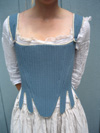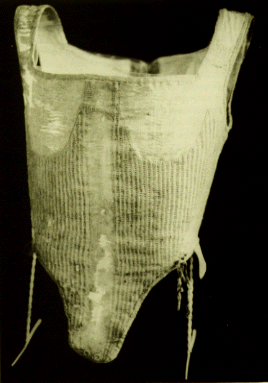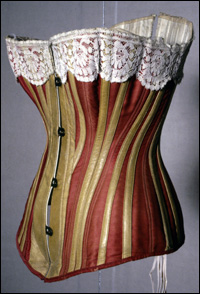Corset
| This article may require cleanup. The specific problem is: information is copied directly from external site. Relevant discussion may be found on the talk page. Please help improve this article if you can. (April 2016) |

Contents
History of
A corset is a close-fitting piece of clothing that has been stiffened by various means in order to shape a woman's torso to conform to the fashionable silhouette of the time. The term "corset" only came into use during the 19th century; before that, such a garment was usually referred to as a pair of bodies, a stiff bodice, a pair of stays or, simply, stays. In French 18th century texts (e.g. Garsault, Diderot), you can find the term corset as a lightly stiffened bodice with tie-on sleeves, whereas proper stays are called corps.
Renaissance and Baroque
The origins of the corset are unknown. From the early 16th century, corset-shaped cages of iron are preserved, but it's almost certain that they had nothing to do with normal clothing. Theories run from early fetish accessories to brute attempts at orthopaedics. Judging from contemporary depictions, stiffened bodices must have been worn around 1530 because the straight, conical line of the torso seen e.g. in portaits of Venetian ladies or Eleanora di Toledo could not have been achieved otherwise. The neckline is relatively high and the chest pressed flat rather than pushed up.
Very few stays from the 16th and 17th century have been preserved. This may be due to the fact that until well into the 17th century, the bodice of the dress itself was stiffened so that an extra corset was unnecessary. Only towards the end of the 17th century, the shaping stays finally became a piece of cothing in its own right, independent from the dress bodice. From now on, ladies dressed not in a combination of skirt and stiff bodice, but in a combination of skirt and jacket or skirt and robe worn over a stiff bodice that had been demoted to underwear.
18th century
In the 18th century, stays are definitely underwear. Only in case of the Robe à l'Allemande, the stiff bodice survived until about 1730, in case of the French court robe even longer. The shape of stays is not much different from that of the 17th century: Conical, pressing the breast up and together, with tabs over the hips. The tabs are formed by cuts from the lower edge up to the waistline that spread when the stays are worn, giving the hips room. They prevent the waistband of the skirt from crawling under the stays, and the waistline of the stays from digging into the flesh.
There are stays that lace at the back (Diderot calls them corps fermé, closed stays) and those that lace across a stiff stomacher in front (corps ouvert, or open stays). Examples that lace both back and front (but not over a stomacher) are quite rare. Stays that lace in front only are even rarer and so far only known to me from the region of Southern Germany. In all these cases, spiral lacing is used.
Although 18th century stays were not meant to be seen, they are often quite decorative, with finely stitched tunnels for the boning, precious silk brocade and possibly gold trim. The inside, on the other hand, usually looks downright sloppy, even in outwardly fine stays.
The basic shape of stays didn't change the whole century long. Towards the end, around 1790, when dress waists begin to wander upwards, the stays become slightly shorter. Since paniers were not worn anymore, the skirt is supported by small pads sewn to the tabs. At the same time, physicians make themselves heard, warning against the harm done by tight-lacing. While lacing wasn't usually overdone as much as one century later, it often started earlier: It started with tightly wrapping babies and included children's corsets, forcing the still soft skeleton into a fashionable shape.
Late Georgian
From 1794, the waist moved higher and arrived just under the bust around 1796. A new kind of corset is needed: The torso, hidden under flowing muslin, doesn't need shaping anymore. The breasts still need lifting, but they're supposed to stay apart. To achieve this, cups are employed for the first time. The busk, which in the 17th century had served to keep the front of the stays straight, now came back into use to keep the cups apart. The shape follows the natural form of the body and widens over the hips by means of triangular inserts.
Since slender figures could keep the bust in shape with the help of only a firm bodice lining, it is mainly stout and over-endowed ones who wear corsets or short stays which already looked like early bras. Therefore, not many corsets from that time have been preserved. Unlike the earlier ones, they tend to be plain and functional. Maybe the fact that they contained less boning led people to refer to them by the (French) term for lightly boned bodices, corset. This is just a theory, but it would explain why the earlier term corps/stays had been replaced with corset by the 1820s.
History of men’s corsets
When we think of corsets we automatically think of women, but men have actually been wearing corsets for just as long. A trim and slim physique has always been fashionable for both men and women.
When 17th and 18th century fashion dictated that men should look physically fit with broad shoulders and a narrow waist the corset was used to create this look. There is a corset pattern at the London Museum, it was reportedly given by Queen Mary to the Museum and it belonged to George IV.
George IV was known to be a very large man and the pattern is 56″ long! Corsets for men were made from a lightweight coutil (cotton), they laced up the back in the same way as a women’s and often had buckled straps at the side to prevent the abdomen bulging. Other styles had elastic inserts at the chest to allow expansion, they were primarily used to give a smart lean contour to evening coats. You can still buy men’s corsets today but they are a lot less common then women’s.

